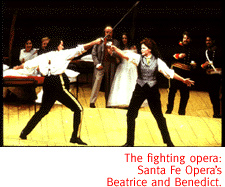
While Opera Elsewhere In The Country Is Struggling, The Lights Are Bright In Santa Fe.
By Robert Baird
IN 1957 MORE, than a few people thought John Crosby was
more than a little loco. Opera on a ranch in New Mexico? Would
New Yorkers and other opera literati actually come to a state
known for stuffed sopapillas and building the atomic bomb?
Forty-two seasons later, Crosby's idiosyncratic vision is alive,
well and in a league with Salzburg, Glyndebourne and the other
great summer opera festivals thanks in part to a gleaming new
theatre.
 Without casting too many aspersions on this season's repertoire,
the star of the 42nd season of the Santa Fe Opera is not what
occurs onstage, but the stage itself. The opera's new digs--a
$19.5-million renovation of it's celebrated hilltop outdoor theatre
just north of Santa Fe--feature a raft of improvements.
Without casting too many aspersions on this season's repertoire,
the star of the 42nd season of the Santa Fe Opera is not what
occurs onstage, but the stage itself. The opera's new digs--a
$19.5-million renovation of it's celebrated hilltop outdoor theatre
just north of Santa Fe--feature a raft of improvements.
For those hardy souls who cherished the old days of opera under
the stars--or more likely, a howling summer monsoon--it's time
to bid adieu to your poncho and golf umbrella: A large, swooping
roof now covers all the seats. That roof, faced on the inside
with narrow wooden slats, and aided sonically by 10 acoustic reflectors
over the stage, has also improved the sound, even for those in
the back of the balcony. Now when the rain beats down you can
still hear the music. The sides of the theatre are still open,
so the al fresco experience is preserved.
Most importantly, the back of the stage remains open so that
on clear nights the lights of Los Alamos can still be seen twinkling
in the distance. The theatre has also been enlarged by 237 seats
for a grand total of 2,126. Three productions attended this season
indicate the opera is having no trouble filling those extra seats.
Other creature comforts include 37 new toilets, an elevator,
a walk-in gift shop, and three full-service bars. Sunsets can
now be viewed from the Stravinsky Plaza, named, of course, for
the composer who always had a special place in his heart for the
little opera lost in the land of enchantment.
Behind and above the stage, there's a new computerized lighting
system, a new network of catwalks (the old ones would have challenged
even the scrawniest alley cat), two emergency generators for when
storms knock the power out, and finally--lest we forget we're
in the Southwest's self-proclaimed City Different ("Fanta
Se" to locals)--an earth-friendly water harvesting system
which gathers raindrops in large tanks for later use in watering
the opera grounds.
 Designed by John Stewart Polschek (of Polschek & Partners
Architects, in New York), the new opera house (the third on this
site since the first opened in 1958) is a striking, white mast-and-rod
structure whose lines are from a distance more than a little reminiscent
of the new Denver airport. There is also what can only be described
as a moat of water ringing the orchestra pit.
Designed by John Stewart Polschek (of Polschek & Partners
Architects, in New York), the new opera house (the third on this
site since the first opened in 1958) is a striking, white mast-and-rod
structure whose lines are from a distance more than a little reminiscent
of the new Denver airport. There is also what can only be described
as a moat of water ringing the orchestra pit.
Prior to the 1999 season, the theatre will receive one last tweak:
the grandly named "electronic libretto system." Instead
of projecting English translations over the stage à la
the Arizona Opera, this $2-million system will project titles
on small screens affixed to the backs of the seats, much like
the system now in use at New York's Metropolitan Opera.
Although many opera patrons hoped for a season whose risks matched
the verve of the new theatre, the 1998 lineup is a fairly typical
Santa Fe-style mix: a bread-and-butter Italian classic (Madame
Butterfly); a broadly appealing Mozart entry (The Magic
Flute); the obligatory Strauss (Salome)--John Crosby
is a huge fan; a mild curveball (Berlioz' Beatrice and Benedict);
and an American premiere (Ingvar Lidholm's A Dream Play).
The last opera to open before press time was Berlioz' Beatrice
and Benedict, which is based on the Shakespearean comedy Much
Ado About Nothing. As is often the case with the SF Opera,
this less-than-standard selection emerges as the season's champ
so far. Brilliantly conducted by Dutch maestro Edo de Waart, this
production sparkled. Tim Albery's direction was nuanced and light,
with many smiles and more than a few outright chuckles. The voices
were outstanding: Beautiful and talented soprano Elizabeth Futral
is simply one of the opera world's brightest up-and-coming stars.
In the lead role, mezzo-soprano Susan Graham affected a horsiness
perfectly suited to this tomboy-like role.
The set design by Antony McDonald (who also did The Magic
Flute) deserves special mention. He takes considerable risks
(or liberties, depending on how traditional you like your opera).
Non-traditionalists will appreciate his artistry as both visually
striking and innovatively versatile. Overall, Beatrice and
Benedict was an attractive, effervescent production.
Richard Strauss' Salome opened July 25 with soprano Helen
Field in the title role, and Crosby conducting; and Lidholm's
A Dream Play opens on August 1, starring American soprano
Sylvia McNair.
Tickets for the Santa Fe Opera range from $15 to $118
and are available by calling 1-800-280-4654. For more information
on lodging, dining and places of interest, contact the Santa Fe
Convention and Visitors' Bureau at 1-800-777-2489.

|





